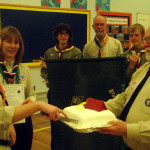Back in December 2014, OnTheWight reported Cllr Jonathan Bacon’s concerns about the low number of A-Level pupils going onto University education.
Reading from the consultation document prepared by Hampshire officers, he told members of the Scrutiny Committee,
“Students completing A-levels progressing to higher education were 27% on the Isle of Wight, 1% to a top third university. That compares nationally to 44% and and 9% respectively.
“This is something we could be doing better.”
Research reveals misleading data
This figure didn’t sit well with a number of OnTheWight readers and when it was raised again last week within our report on A-Level results. OnTheWight contributor, Wendy Varley, decided to look further into statistics, raising it in Readers’ comments.
Digging through the historical data provided by the Department for Education, it became clear the figure quoted in the consultation paper was not only inaccurate, but also misleading.
This figure is important as it’s one of those used to strengthen the argument for change in post-16 provision on the Island and quoted several times in the consultation document.
Only college data used
The 27% statistic cited in the consultation paper and council meetings relates only to those taking A-Levels and going onto higher education from the Isle of Wight College.
It doesn’t include statistics of A-Level pupils from the Island’s secondary schools as it should have done.
The correct figure for the year cited (2011/12) should have been 43% not 27%, with the national average at 53%.
Improvements being made
Data for the following year (2012/13) was released earlier last week (after the launch of the consultation).
It shows some improvement with the number of A-Level pupils (from both college and schools) on the Isle of Wight going onto higher education raising two percentage points to 45% (national average 48%).
Those A-Level pupils from the college moving up to higher education jumped from 27% to 37% (just two points away from the national average 39%, for colleges).
Who checks the data?
Whilst it is clear there are other issues within the education system on the Isle of Wight that need to be tackled, the council has stressed this consultation has to be taken seriously.
Errors likes these – that have to be discovered and corrected by members of the general public, albeit ones with a passion for education on the Island – have the potential to shake confidence in the veracity of the entire document.
Hampshire education officers compiling the report should have been able to skip through the DfE spreadsheets with great ease – locating the correct figures.
Other errors, such as unfinished sentences and typos, are also found in the document.
OnTheWight understand the council are due to address the 27% error this morning. It’s hoped that, for the sake of confidence in this important document, it’s been thoroughly reviewed and all mistakes corrected.
Below is how the council chose to ‘bring it to peoples’ attention’, buried in the middle of a positive press release issued this morning (Monday).
SECONDARY AND POST 16 CONSULTATION ALREADY PROVING POPULAR
The Isle of Wight Council is welcoming queries, comments and challenges that are beginning to come in as part of the recently launched consultation on school and post-16 places.
The consultation was launched on 26 January and runs until 30 April, with a number of public meetings planned – the first at Carisbrooke College at 6pm on Tuesday 3 February.
Isle of Wight Council leader and Executive member for children’s services, Jonathan Bacon, said:
“We are already seeing a steady stream of emails as part of the consultation with various comments and queries including challenges to the accuracy of some information. I really welcome the fact that the full public engagement has now started and that people are taking the time to read and respond.
“It will be through this robust public scrutiny, in which I hope many people on the Island will engage, that everyone should ultimately be satisfied that we are considering all the relevant and accurate information and that this is a full and open consultation where all views will be listened to and considered.”
As a result of feedback so far the council is amending the figures quoted on page 6 of the consultation document in relation to the percentage of A-Level leavers who move onto higher education.
The figures quoted related only to those young people at a college of whom 27 per cent of Isle of Wight leavers were moving into higher education compared to a national (college leavers) average of 44 per cent. The figures that should have been shown are for all young people in schools and colleges. These are 43 per cent of Isle of Wight leavers moving to higher education compared to 53 per cent nationally. Recently released (Tuesday 27 January) figures from the DfE for the 2012/13 academic year shows the national average for all young people in schools and colleges has dropped to 48 per cent which the Isle of Wight average has risen to 45 per cent.
This will be corrected on the www.iwight.com/schools page where the consultation document and supporting data can be found.
Councillor Bacon added
“I want to thank the member of the public who first brought this to our attention. This has enabled us to make the necessary changes at a very early stage of the consultation. It was an error on our behalf for which we apologise.
“The overriding message remains the same though – that we are still behind the national averages on this and other key outcomes for our young people and improvements need to be made.”
The Frequently Asked Questions section of the consultation web pages at www.iwight.com/schools will be constantly updated to ensure it covers all queries raised during the consultation. There will also be messages posted should something new be added, including further information and background materials. There will also be a page that explains any corrections or changes to the consultation document – what they were and when they were made.
Image: horiavarlan under CC BY 2.0





